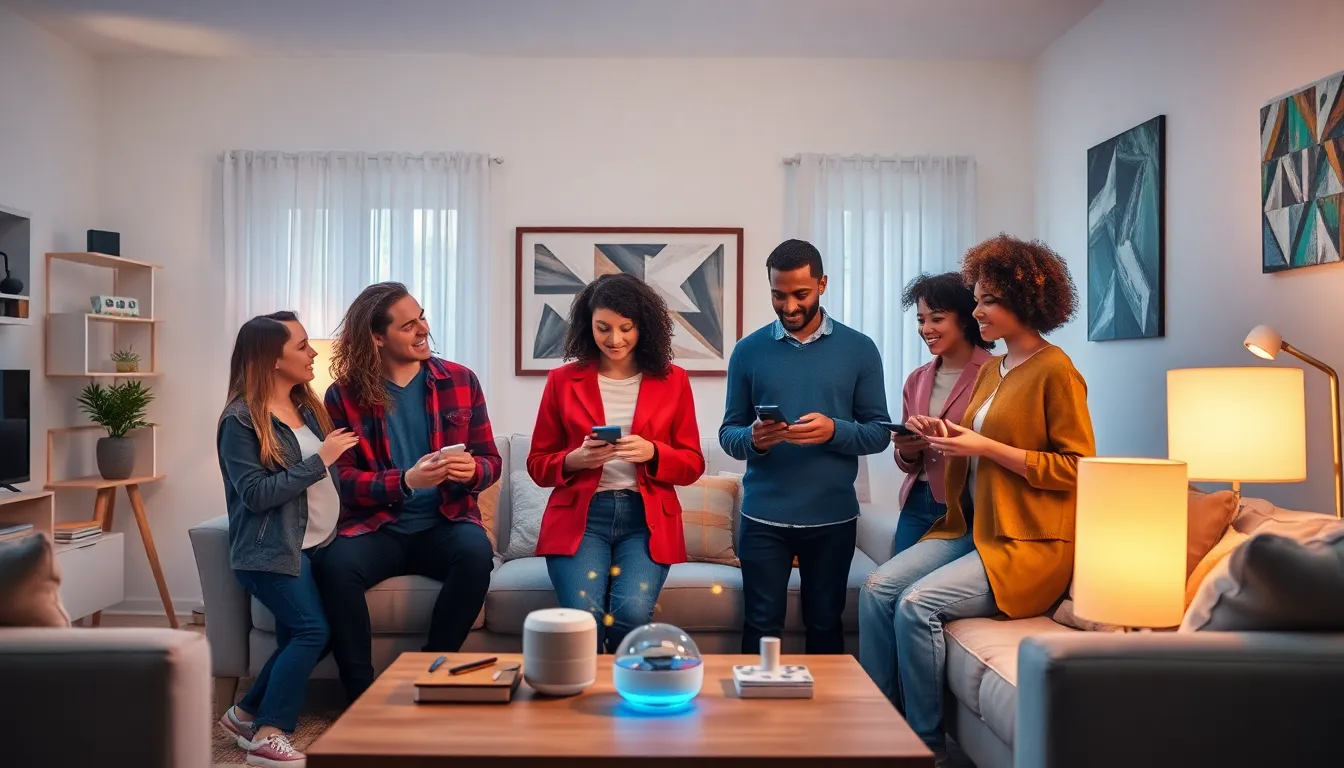Imagine walking into your home and having it greet you like an old friend. With hands-free home automation, that dream’s a reality. No more fumbling for light switches or remote controls. Instead, a simple voice command transforms your space into a smart haven, ready to cater to your every whim.
Table of Contents
ToggleOverview Of Hands-Free Home Automation
Hands-free home automation focuses on providing seamless interaction with home systems through voice commands. This technology simplifies everyday tasks, allowing individuals to control lighting, heating, security, and entertainment systems effortlessly. Various devices, such as smart speakers and hubs, serve as the central control point.
Users can issue commands to adjust thermostats for desired temperatures or turn lights on and off. Control of appliances also extends to the kitchen, making meal preparation more convenient. Many people enjoy the comfort of managing their home environment without physical interaction, especially when their hands are full.
Integration with artificial intelligence enhances functionality. Smart assistants can learn user preferences over time, increasing efficiency. For example, an automated schedule could turn off lights during the day or adjust heating based on occupancy, saving energy and costs.
Voice recognition technology ensures accurate responses to commands. Systems that utilize natural language processing understand user intent, facilitating quick actions. Compatibility with various platforms allows for broad home integration, ensuring devices work together harmoniously.
Data privacy remains a vital consideration. Users often seek solutions that secure their personal information while enjoying automation. Many manufacturers now prioritize security measures in their products, offering features that protect against unauthorized access.
Hands-free home automation reshapes modern living, promoting comfort and efficiency. As technology evolves, new innovations continue to emerge, enhancing the overall experience and accessibility of smart homes. This transformation influences how individuals interact with their living environments, making everyday tasks easier and more convenient.
Benefits Of Hands-Free Home Automation

Hands-free home automation offers significant advantages that enhance daily living. It promotes ease of use and improved security, transforming home environments.
Convenience And Accessibility
Convenience stands out as a primary benefit of hands-free home automation. Voice commands facilitate control over various home features like lighting and heating. Individuals can adjust settings without needing physical contact, which is vital when their hands are occupied. Accessibility increases for individuals with mobility challenges, allowing them to interact with their environment effortlessly. Smart speakers and hubs streamline the experience, making tasks manageable through simple spoken phrases. These systems often integrate with existing devices, enhancing functionality without requiring extensive setup or manipulation.
Enhanced Security Features
Enhanced security features significantly elevate the appeal of hands-free home automation. Smart home systems incorporate advanced monitoring capabilities, providing real-time alerts on unusual activities. Voice-controlled security cameras offer remote viewing, ensuring peace of mind when away from home. Automated locks can be engaged or disengaged through voice commands, improving security without fumbling for keys. Alerts inform users about security breaches or suspicious movements, allowing for immediate action when necessary. Overall, these features not only protect the home but also foster a sense of safety for residents.
Key Technologies Behind Hands-Free Home Automation
Hands-free home automation relies on various key technologies that ensure seamless interaction and convenience. This section explores two main components: voice recognition systems and integration with smart devices.
Voice Recognition Systems
Voice recognition systems process spoken commands, translating them into actions. These systems utilize sophisticated algorithms to understand natural language. Enhanced accuracy results from continuous learning of user preferences and speech patterns. They improve user experience by responding quickly and correctly. Users appreciate the hands-free interaction, which allows them to control home features while engaged in other activities. Manufacturers focus on refining this technology to ensure reliable performance across diverse accents and languages. Comprehensive voice recognition systems empower users to manage lighting, climate, and security with ease.
Integration With Smart Devices
Integration with smart devices forms the backbone of hands-free automation. Smart speakers and hubs connect various gadgets within a home network. Compatibility across platforms encourages consistent communication between devices. Users can control everything from thermostats to kitchen appliances effortlessly. Expanding device compatibility enhances the smart home experience, creating an ecosystem that responds to voice commands. Integration streamlines daily tasks, transforming how individuals interact with their living spaces. Prioritizing interoperability among devices ensures a versatile solution that adapts to users’ preferences and routines.
Popular Hands-Free Home Automation Systems
Hands-free home automation systems enhance convenience and control within smart environments. They allow seamless management of various devices through voice commands.
Smart Assistants Comparison
Smart assistants like Amazon Alexa, Google Assistant, and Apple Siri dominate the market. Amazon Alexa excels in compatibility with numerous smart devices, ensuring a wide range of user options. Google Assistant stands out for its natural language processing, making voice interactions feel intuitive. Apple Siri integrates uniquely with iOS devices, appealing to users within the Apple ecosystem. Each assistant offers distinct features, and users can choose based on their specific needs and existing devices.
Compatible Devices And Ecosystems
Compatibility remains crucial in hands-free home automation systems. Users can connect smart speakers, thermostats, security cameras, and lights effortlessly within their home networks. Amazon Echo devices work seamlessly with various brands, including Philips Hue and Nest. Google Nest products often integrate smoothly with other smart home gadgets, allowing extensive control options. Apple HomeKit supports devices from brands like Ecobee and Logitech, focusing on secure connections. Choosing the right ecosystem simplifies interactions and enhances the overall smart home experience.
Hands-free home automation represents a significant shift in how individuals interact with their living spaces. By leveraging voice commands and smart technology, it simplifies daily tasks and enhances overall convenience. This innovative approach not only promotes comfort and efficiency but also caters to various lifestyles and needs.
With the integration of artificial intelligence and voice recognition, users can enjoy a seamless experience that adapts to their preferences. As these technologies continue to evolve, they promise to further enrich the smart home landscape, making it more accessible and secure for everyone. Embracing hands-free automation can transform any home into a responsive environment that prioritizes user comfort and safety.




